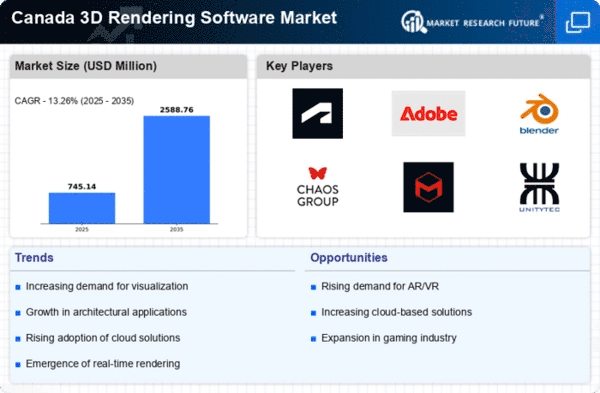Rising Demand in Entertainment and Media
The entertainment and media sectors in Canada are experiencing a notable surge in demand for high-quality visual content, which significantly influences the 3d rendering-software market. As the industry evolves, there is an increasing need for realistic animations and visual effects in films, video games, and virtual reality experiences. This trend is evidenced by a projected growth rate of approximately 15% annually in the Canadian entertainment sector, which directly correlates with the rising adoption of advanced rendering software. Companies are investing heavily in 3d rendering technologies to enhance their production capabilities, thereby driving the market forward. The integration of sophisticated rendering tools allows for the creation of immersive experiences that captivate audiences, further solidifying the importance of the 3d rendering-software market in meeting these evolving demands.
Growing Need for Customization and Personalization
The growing need for customization and personalization in various industries is emerging as a significant driver for the 3d rendering-software market. As consumers increasingly seek tailored experiences, businesses are turning to 3d rendering software to create unique products and services. This trend is particularly evident in sectors such as retail, where brands are utilizing 3d rendering to offer personalized product visualizations. The market for customized products is expected to grow by 20% over the next five years, indicating a strong demand for rendering solutions that can accommodate these needs. By leveraging advanced rendering technologies, companies can enhance customer engagement and satisfaction, thereby reinforcing the relevance of the 3d rendering-software market in meeting these evolving consumer expectations.
Technological Advancements in Rendering Techniques
Technological advancements in rendering techniques are significantly shaping the 3d rendering-software market. Innovations such as real-time rendering, ray tracing, and cloud-based rendering solutions are becoming increasingly prevalent in Canada. These advancements allow for faster processing times and improved visual fidelity, which are crucial for industries such as gaming, film, and architecture. The market is projected to grow by approximately 12% annually as companies adopt these cutting-edge technologies to stay competitive. As rendering software becomes more sophisticated, it enables creators to produce high-quality visuals that meet the demands of modern consumers. This trend indicates a strong future for the 3d rendering-software market as it adapts to the rapid pace of technological change.
Expansion of the Architectural Visualization Sector
The architectural visualization sector in Canada is undergoing significant expansion, which is a key driver for the 3d rendering-software market. As urban development projects increase, architects and designers are increasingly relying on 3d rendering software to create detailed visual representations of their designs. This trend is supported by a growing investment in infrastructure, with the Canadian government allocating over $100 billion for infrastructure projects in the coming years. The ability to present realistic 3d models to clients enhances communication and decision-making processes, making rendering software indispensable in the architectural field. Furthermore, the demand for sustainable and innovative designs necessitates advanced visualization tools, thereby propelling the growth of the 3d rendering-software market.
Increased Investment in Virtual and Augmented Reality
The rise of virtual and augmented reality (VR and AR) applications in Canada is driving growth in the 3d rendering-software market. As businesses across various sectors, including education, healthcare, and retail, explore VR and AR solutions, the demand for high-quality 3d rendering software is expected to increase. The Canadian VR market alone is projected to reach $1.5 billion by 2026, highlighting the potential for growth in related software markets. Companies are recognizing the value of immersive experiences, which require advanced rendering capabilities to create realistic environments. This trend suggests that the 3d rendering-software market will continue to expand as more industries integrate VR and AR technologies into their operations.

















Leave a Comment